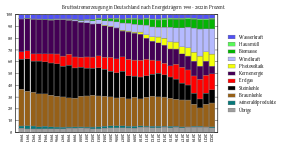| Data | |
|---|---|
| Continuity of supply | 0.2815 h (16.89 min) interruption per subscriber per year |
| Installed capacity (2020) | 211.31 GW[1] |
| Production (2021) | 490.6 TW⋅h[2] |
| Share of fossil energy | 40.9% (2021)[2] |
| Share of renewable energy | 55% (2023) |
| GHG emissions from electricity generation (2013) | 363.7 Mt CO2 [631.4 TW⋅h × 576 g/kW⋅h] |
| Tariffs and financing | |
| Average industrial tariff (US$/kW·h, 2013) | medium: 20.60[3] |

Germany's electrical grid is part of the Synchronous grid of Continental Europe. In 2020, due to COVID-19 conditions and strong winds, Germany produced 484 TW⋅h of electricity of which over 50% was from renewable energy sources, 24% from coal, and 12% from natural gas, this amounting to 36% from fossil fuel .[4] This is the first year renewables represented more than 50% of the total electricity production and a major change from 2018, when a full 38% was from coal, only 40% was from renewable energy sources, and 8% was from natural gas.[5]
In 2023, 55% of energy produced was from renewable energy source; a 6.6 percentage points increase from 2022.[6] Within the 55%, 31.1% was attributed to wind, 12.1% to solar, 8.4% to biomass and the remaining 3.4% from hydropower and other renewable.[6]
Germany has consistently produced the most carbon dioxide emissions in the European Union since the turn of the century, a large proportion of this coming from coal and lignite burning power stations, 7 of which are included in Europe's top 10 most CO2 polluting list of 2021.
In 2022, Germany produced nearly 635 million metric tons of carbon dioxide emissions. This was more than the combined emissions produced by the next largest emitters in the EU – Italy and Poland. These three countries accounted for roughly 46 percent of total EU carbon dioxide emissions in 2022.
Germany's installed capacity for electric generation increased from 121 gigawatts (GW) in 2000 to 218 GW in 2019, an 80% increase, while electricity generation increased only 5% in the same period.[7]
Even though renewables production increased significantly between 1991 and 2017, fossil power production remained at more or less constant levels. In the same period, nuclear power production decreased due to the phase-out plan, and much of the increase in renewables filled the gap left behind by closing nuclear power plants. However 2019 and 2020 saw significant reductions in electricity generation from fossil fuel, from 252 TW⋅h in 2018 to 181 TW⋅h in 2020. The German government decided to phase-out nuclear power by end of 2022, however this has been delayed until April 2023 due to supply disruption caused by the Russian invasion of Ukraine,[8] meaning that future growth in renewables will be needed to fill the gap again. Germany also plans to phase out coal by 2038 or earlier.[9]
- ^ "Energy-Charts". www.energy-charts.info.
- ^ a b Burger, Bruno (14 February 2022). Öffentliche Nettostromerzeugung in Deutschland im Jahr 2021 [Public Net Electricity Generation in Germany in 2021] (PDF) (in German). Freiburg, Germany: Fraunhofer-Institut für Solare Energiesysteme ISE. Retrieved 17 May 2022.
- ^ "Energie-Info EE und das EEG2013" (PDF). BDEW. 2013. Archived from the original (PDF) on 15 August 2013. Retrieved 21 June 2016.
- ^ Burger, Bruno (4 January 2021). Public Net Electricity Generation in Germany 2020 (PDF). Freiburg, Germany: Fraunhofer Institute for Solar Energy Systems ISE. Retrieved 3 June 2021.
- ^ "Electricity generation | Energy Charts". www.energy-charts.de. Fraunhofer ISE. Retrieved 3 June 2020.
- ^ a b "Renewable energy's share on German power grids reaches 55% in 2023". Reuters. 3 January 2023.
- ^ "Germany's Energiewende, 20 Years Later".
In 2000, Germany had an installed capacity of 121 gigawatts and it generated 577 terawatt-hours, which is 54 percent as much as it theoretically could have done (that is, 54 percent was its capacity factor). In 2019, the country produced just 5 percent more (607 TW⋅h), but its installed capacity was 80 percent higher (218.1 GW) because it now had two generating systems.
- ^ "Germany: Nuclear phase-out postponed for three and a half months".
- ^ Cite error: The named reference
coalshutdownwas invoked but never defined (see the help page).